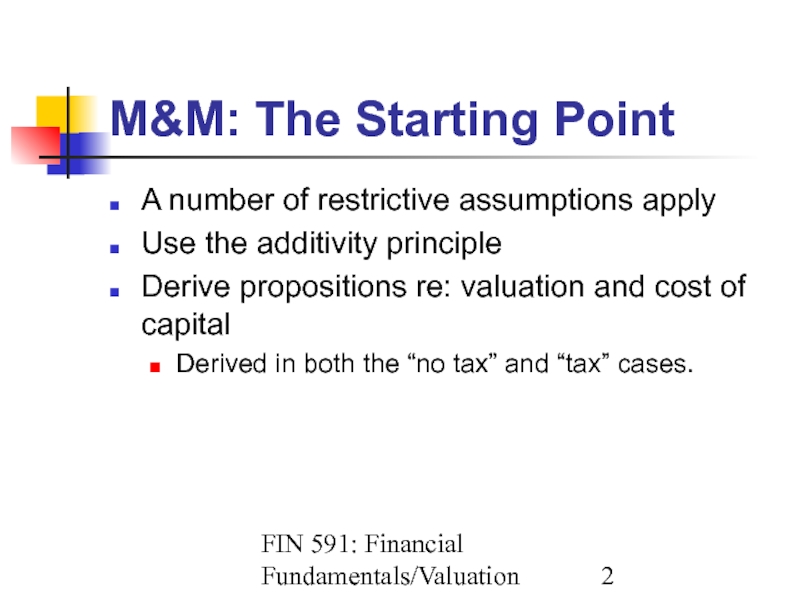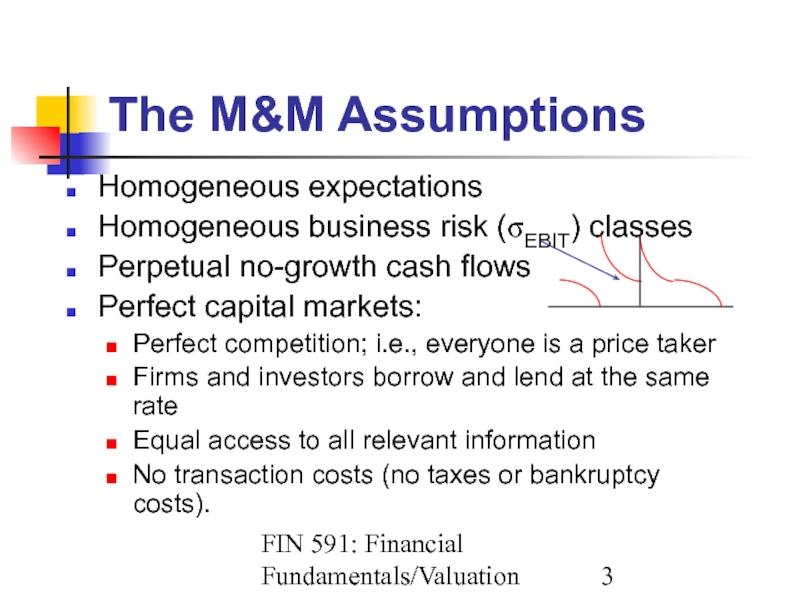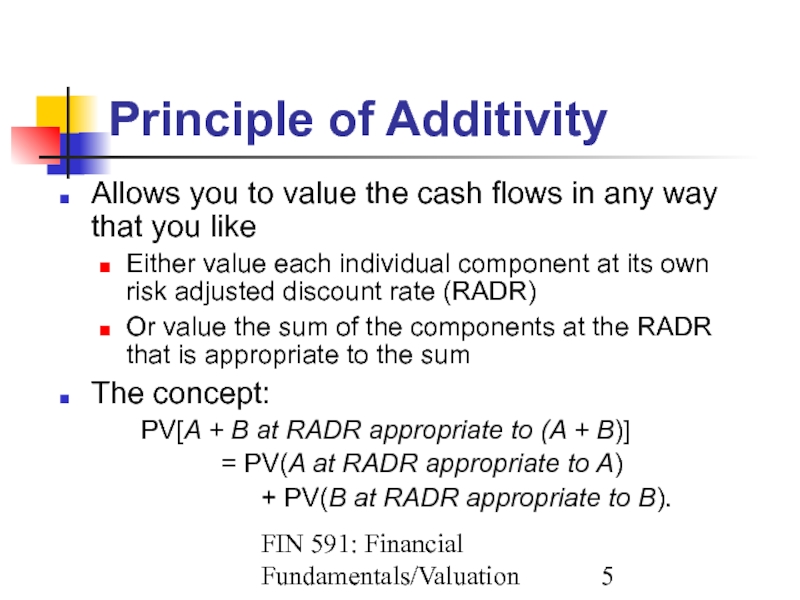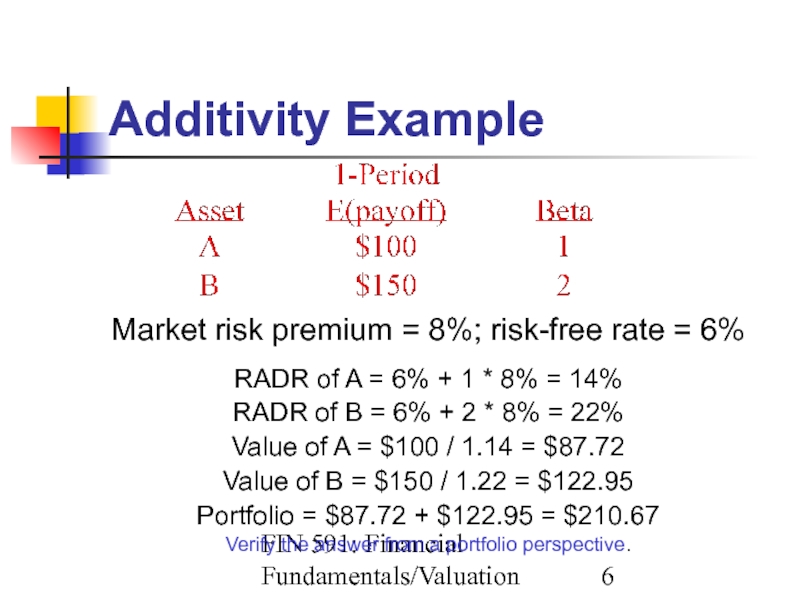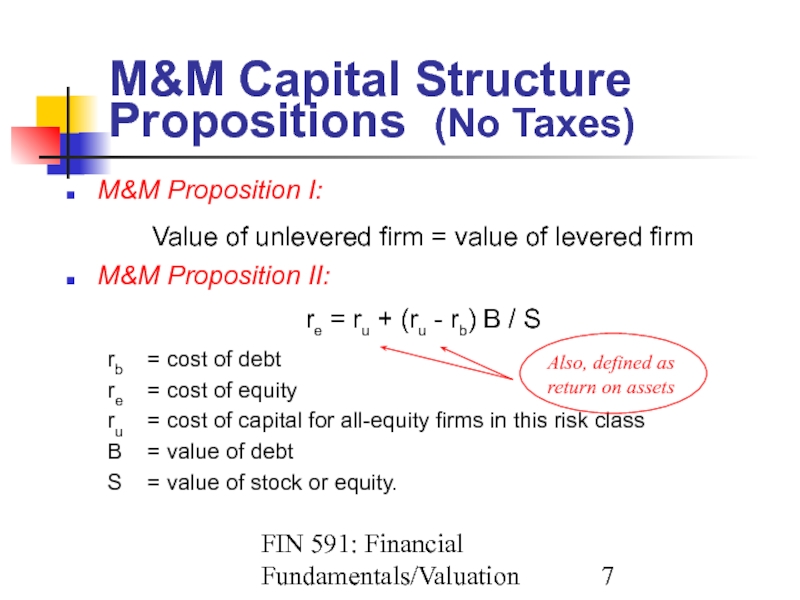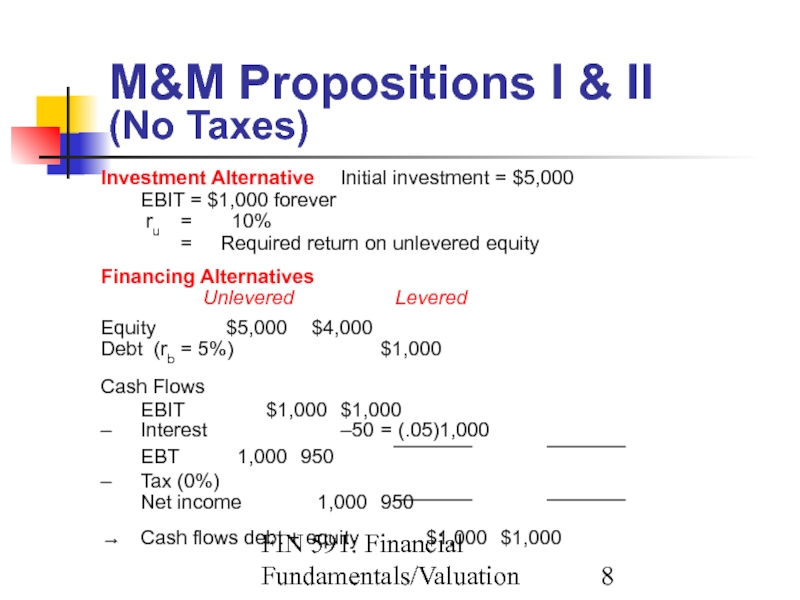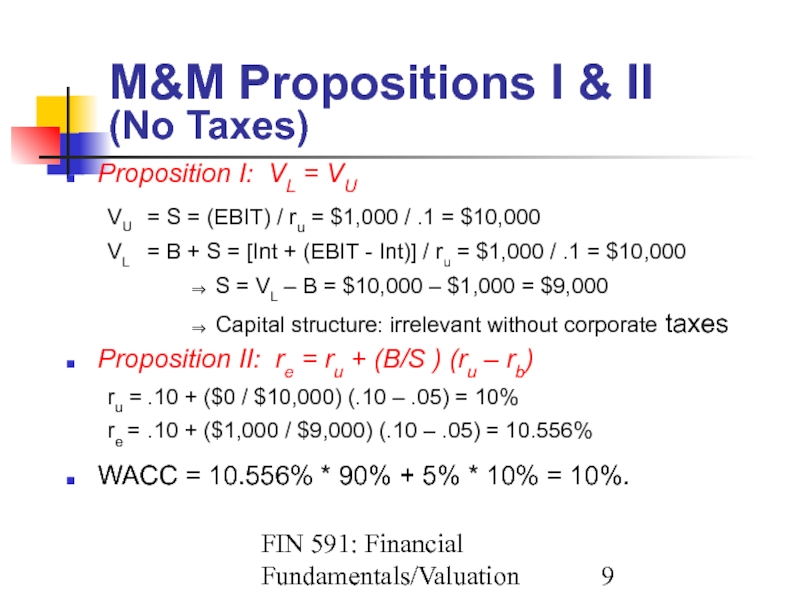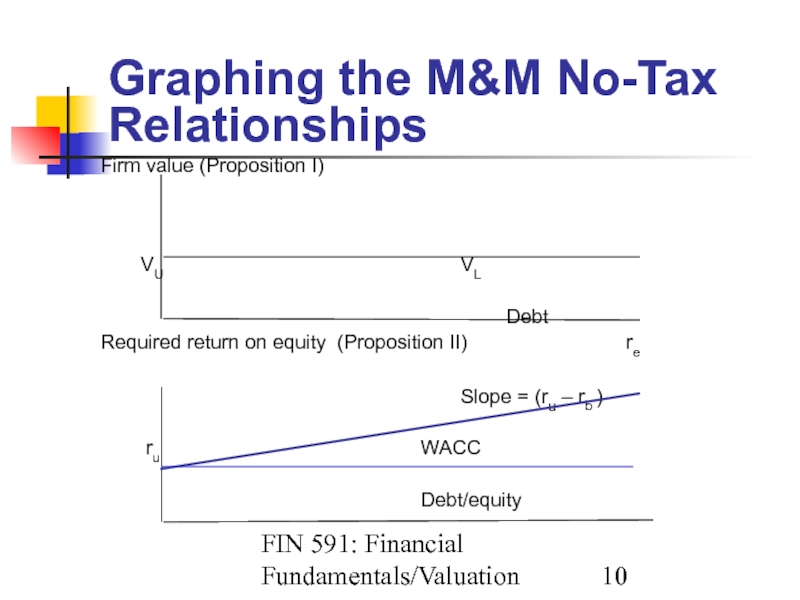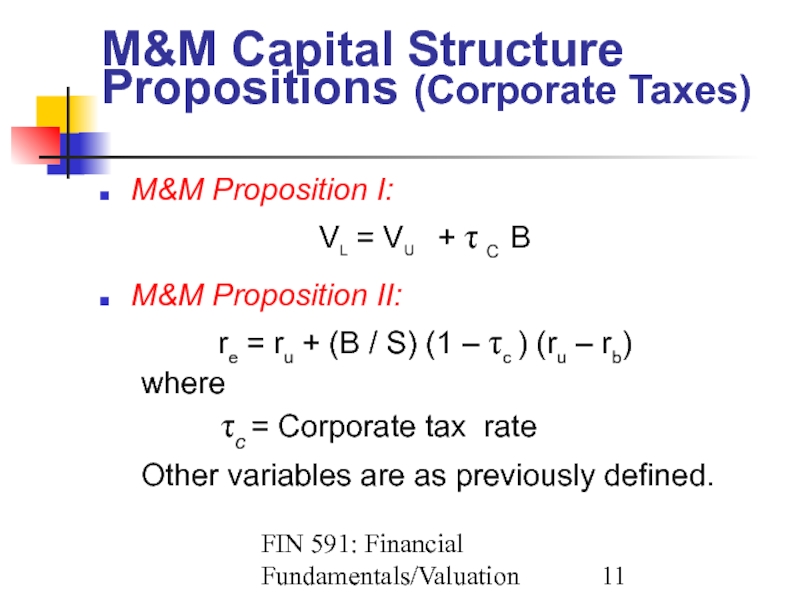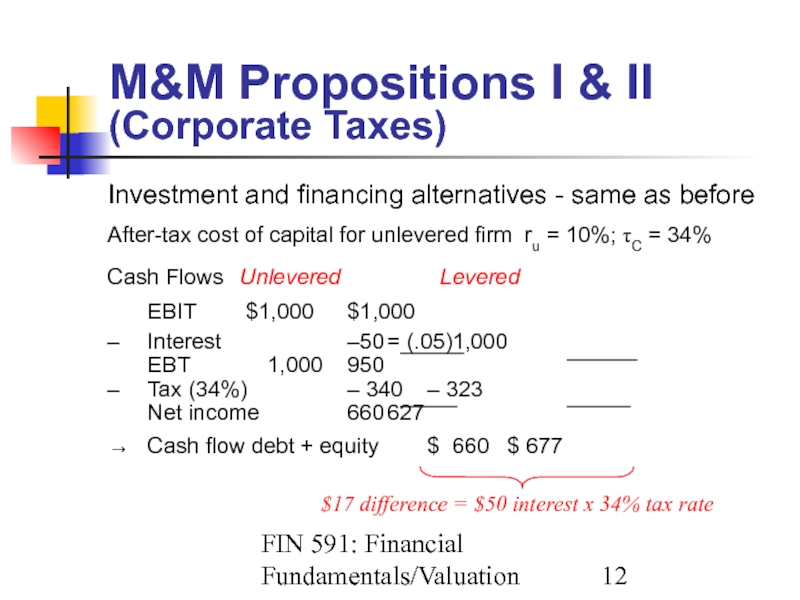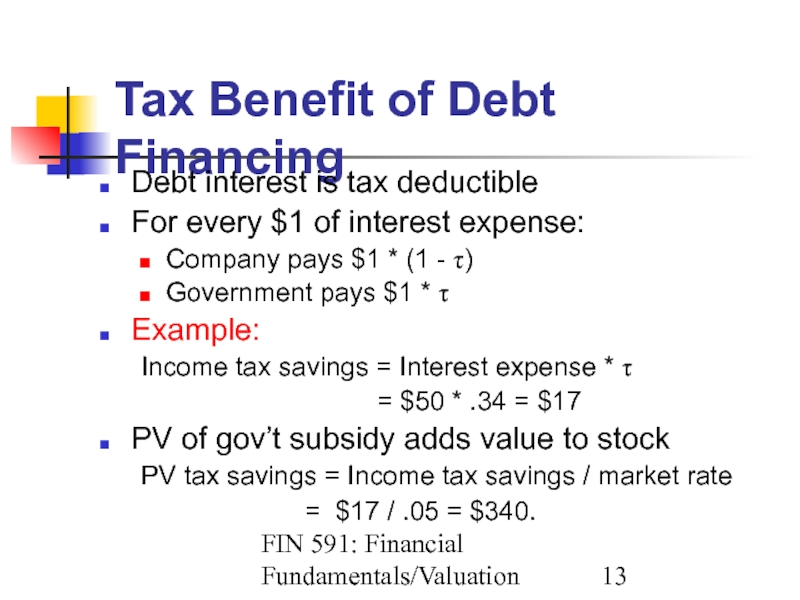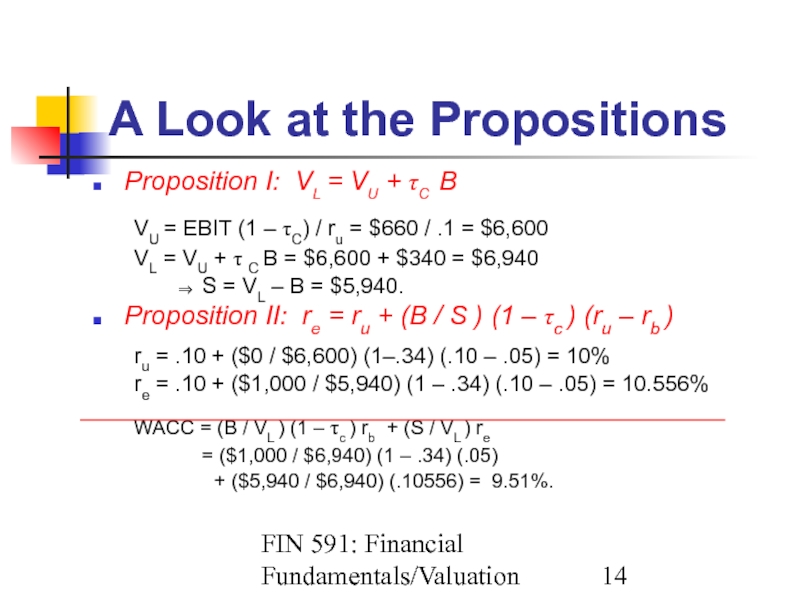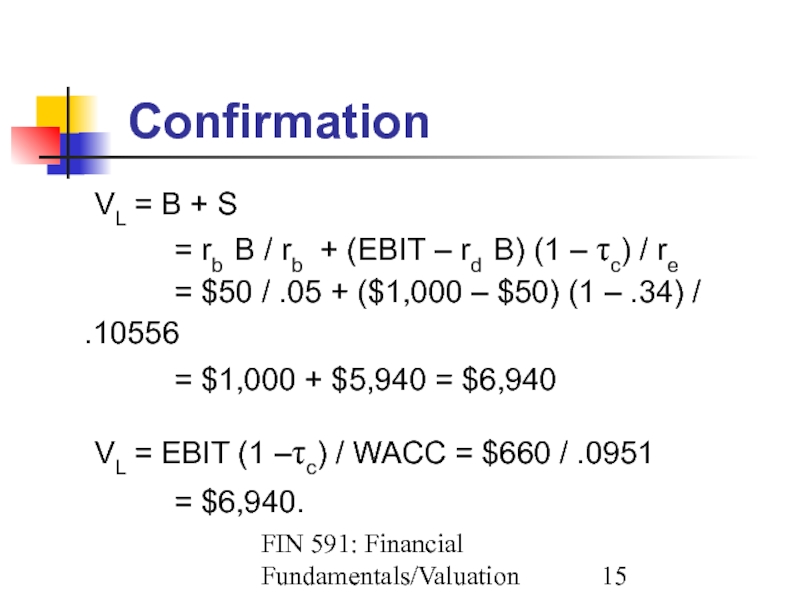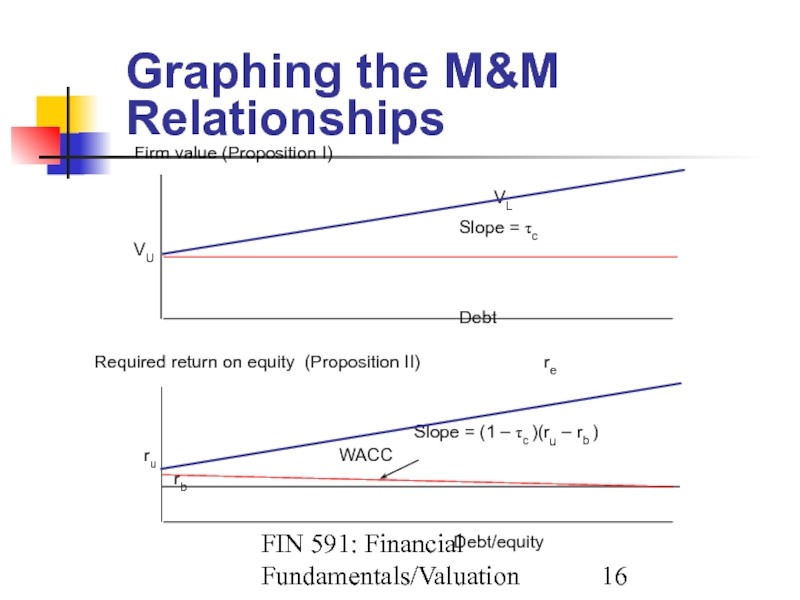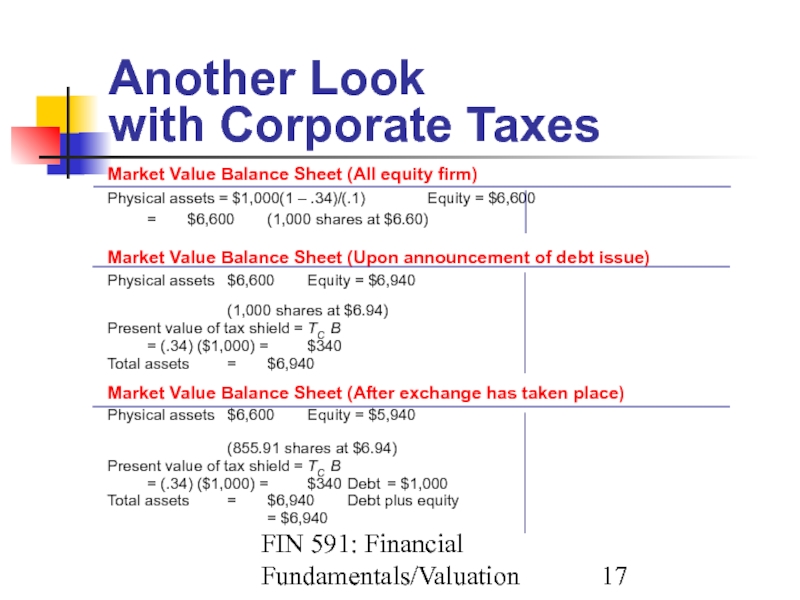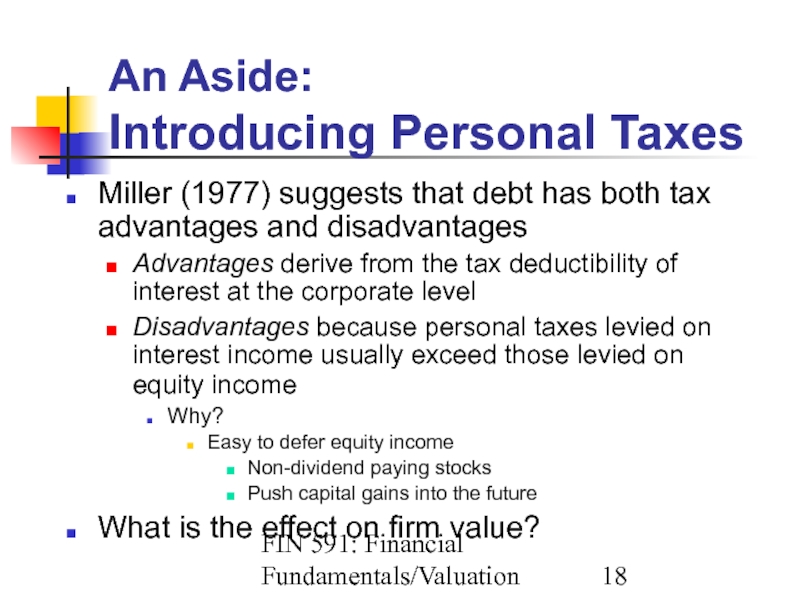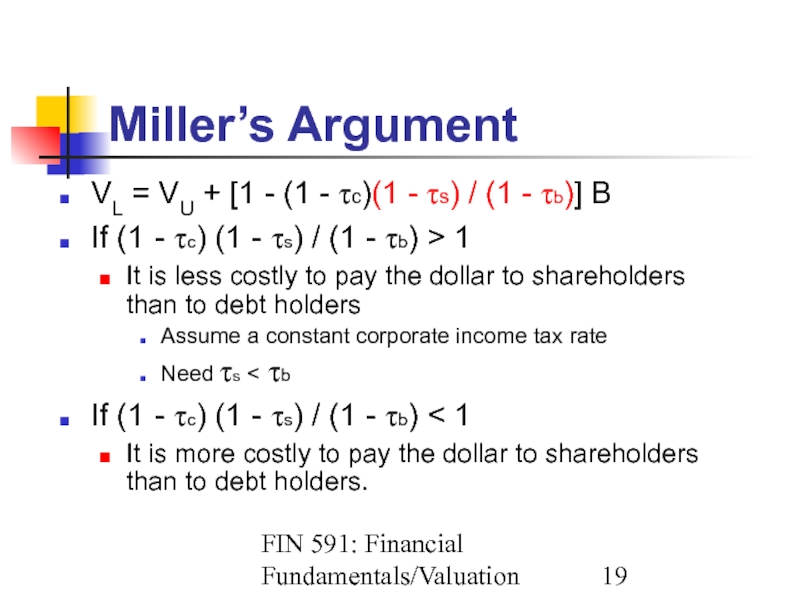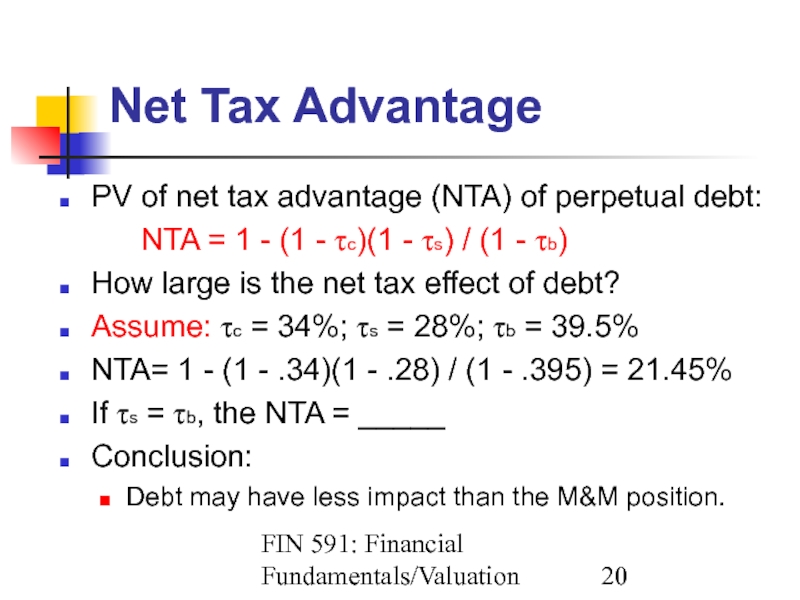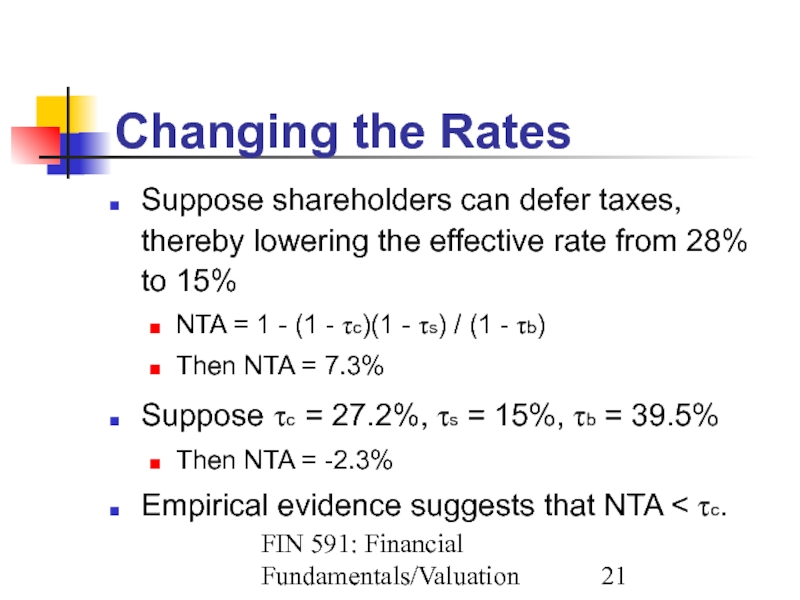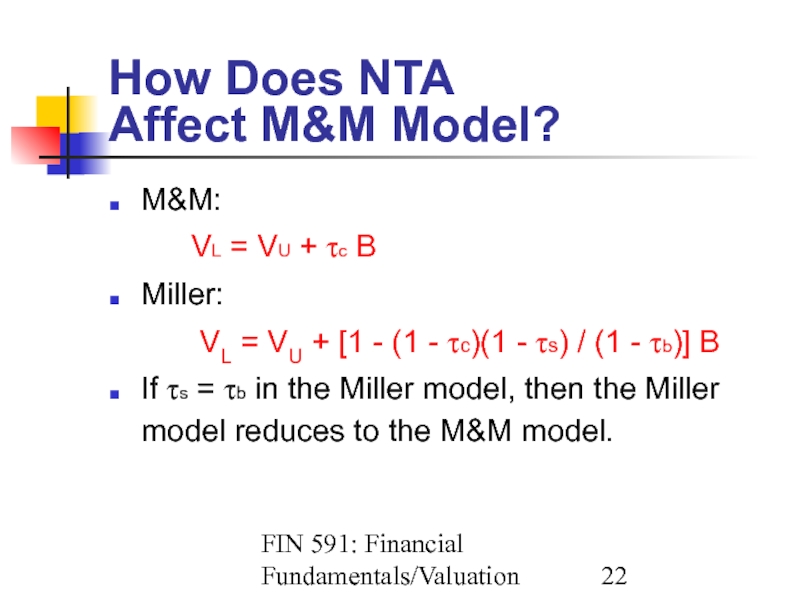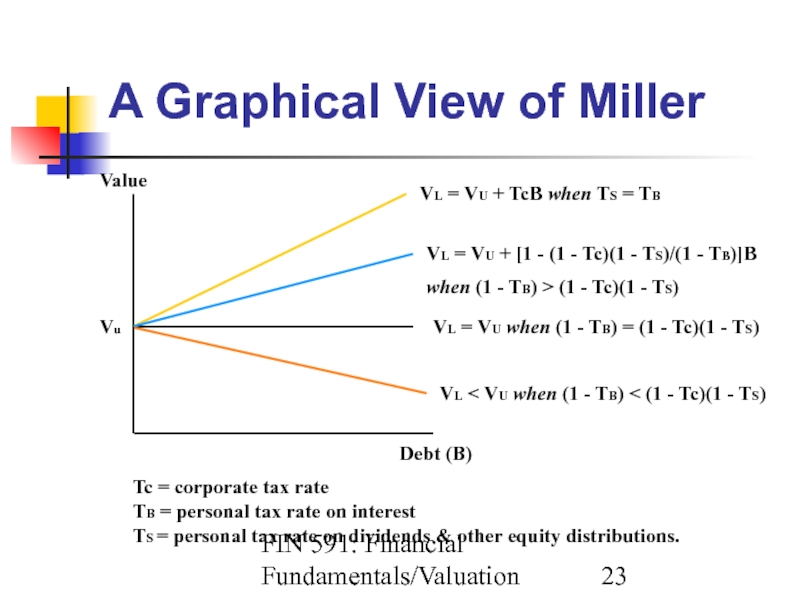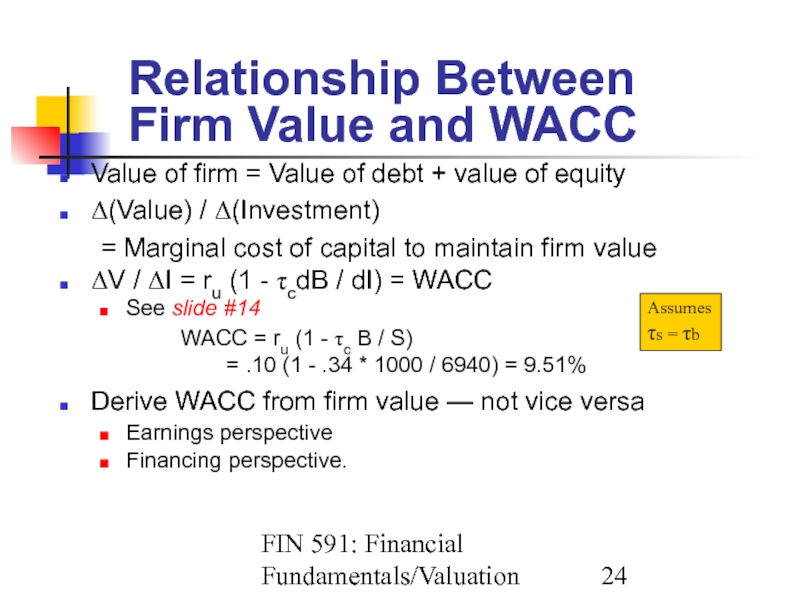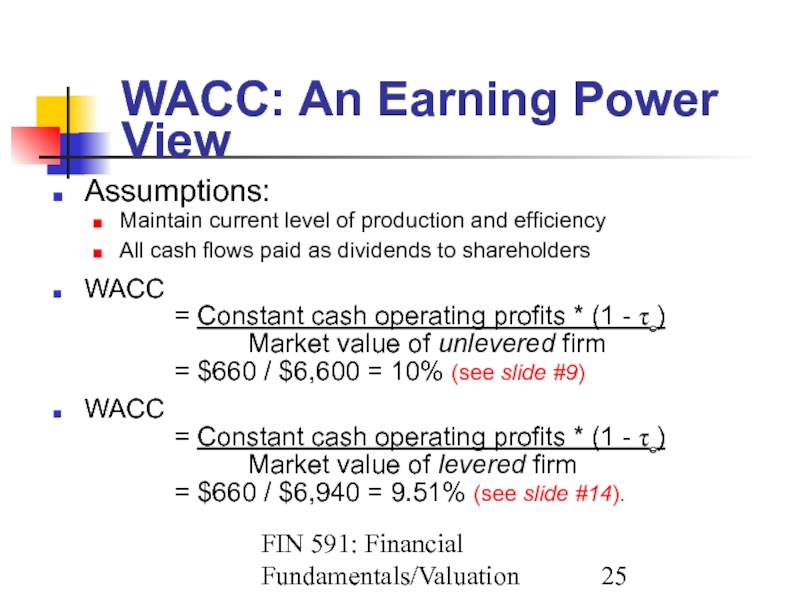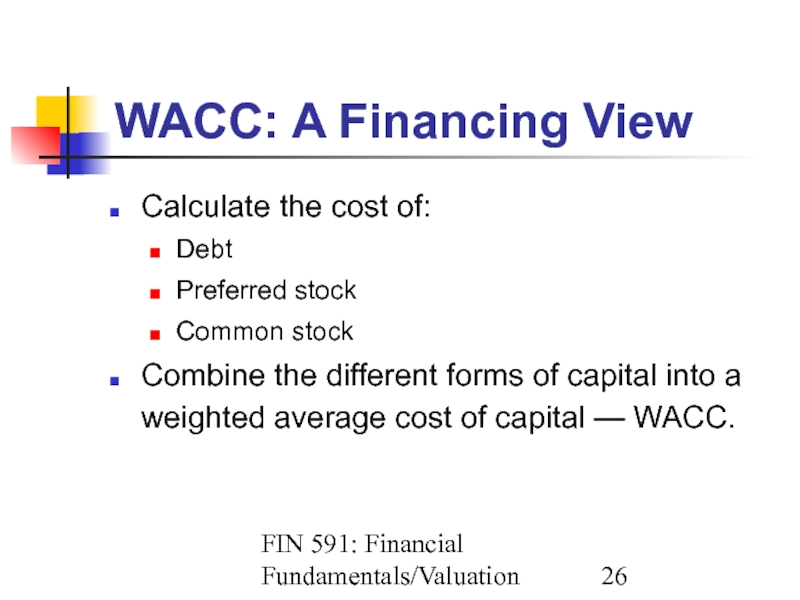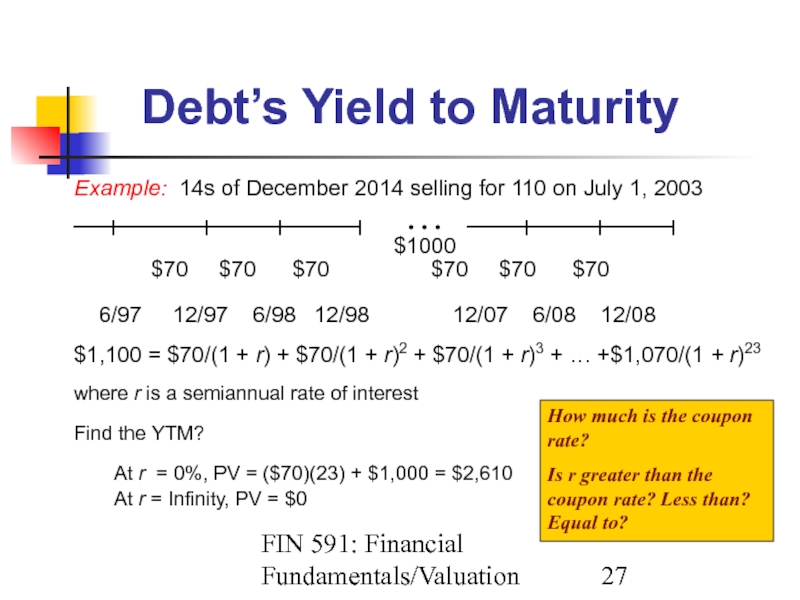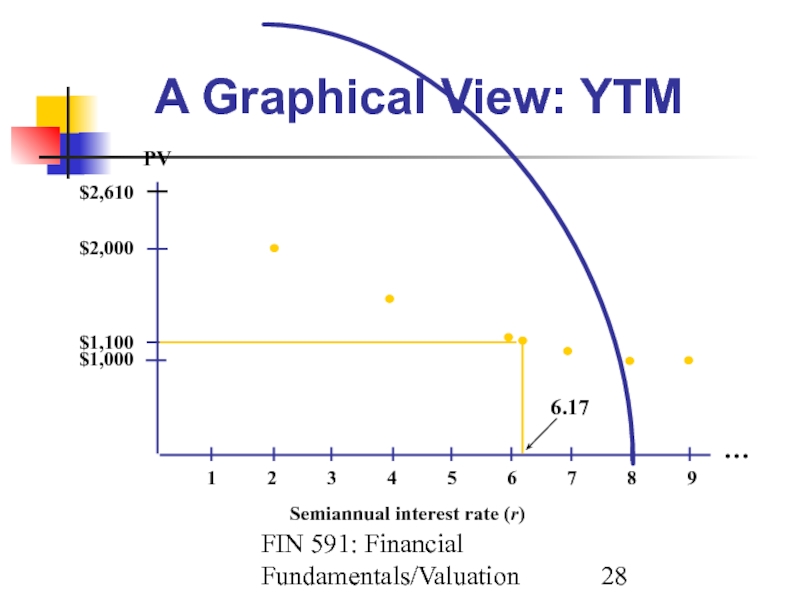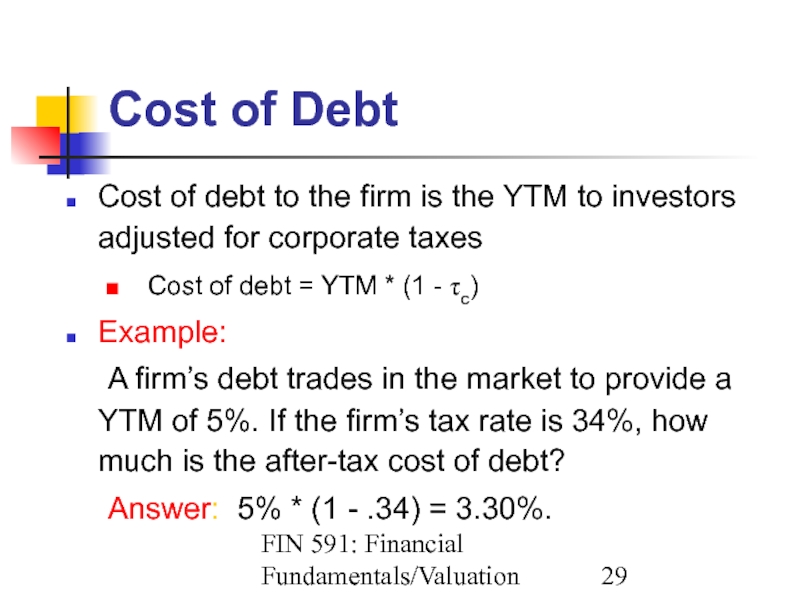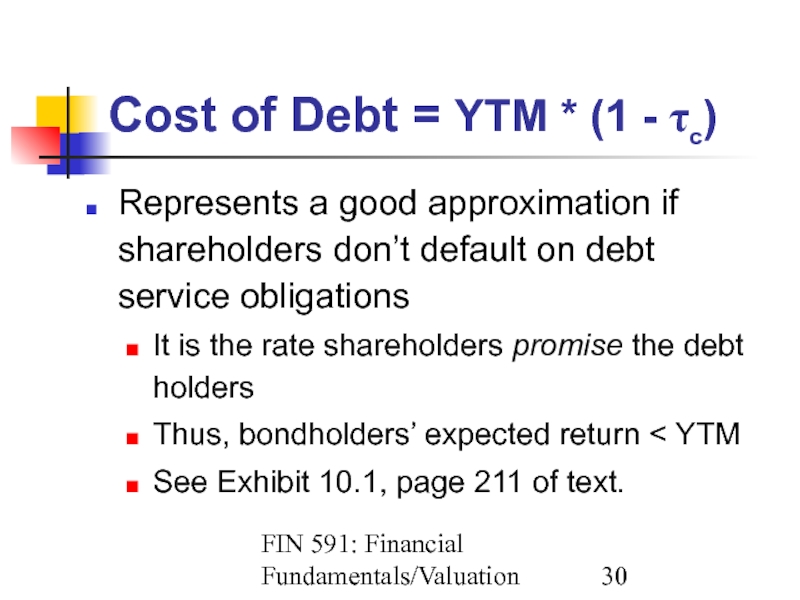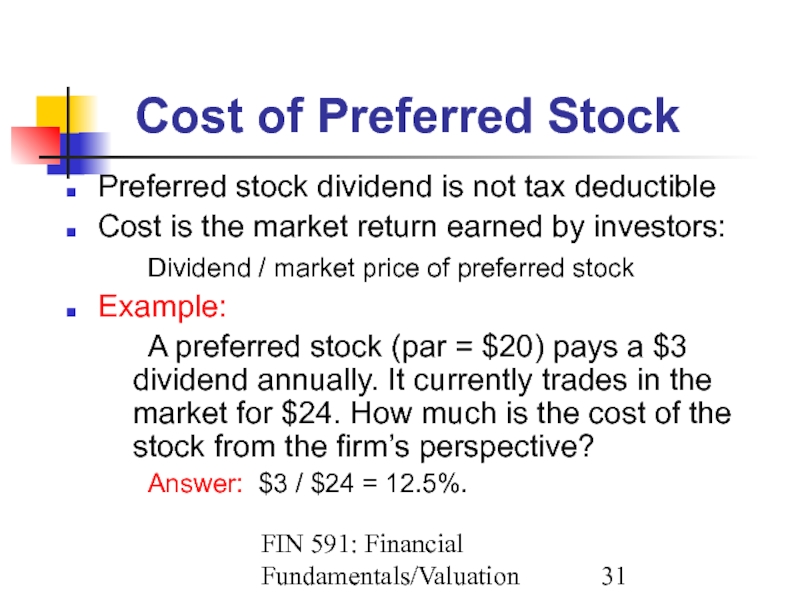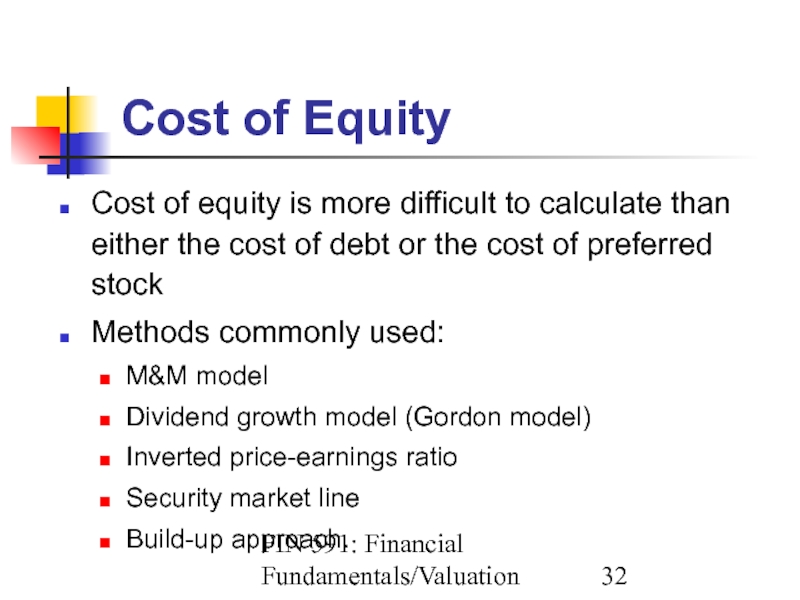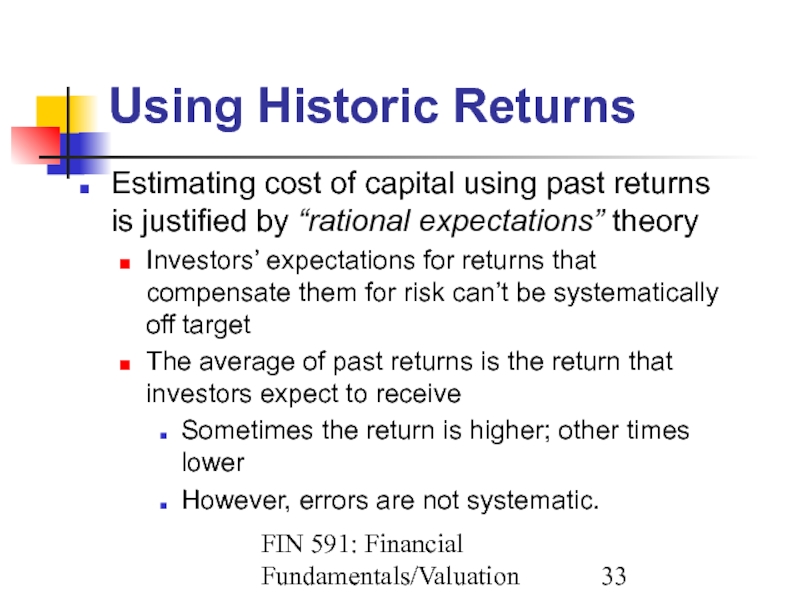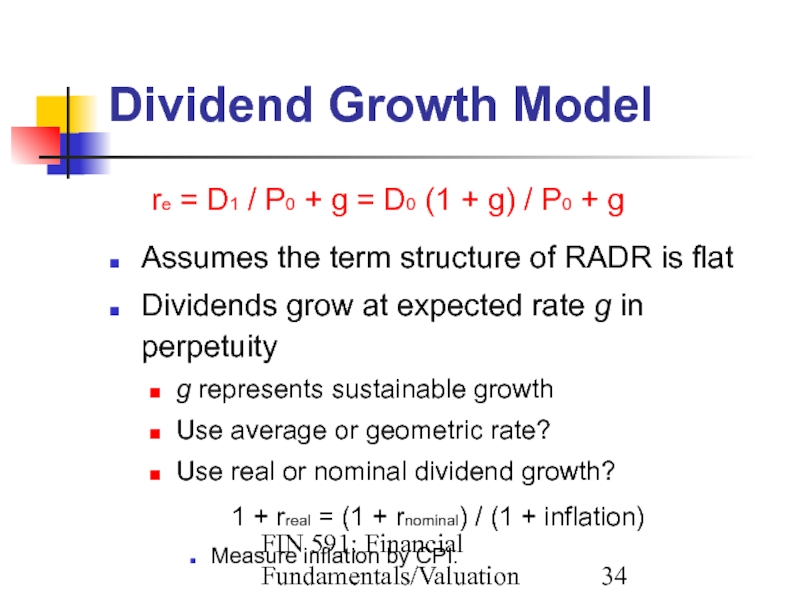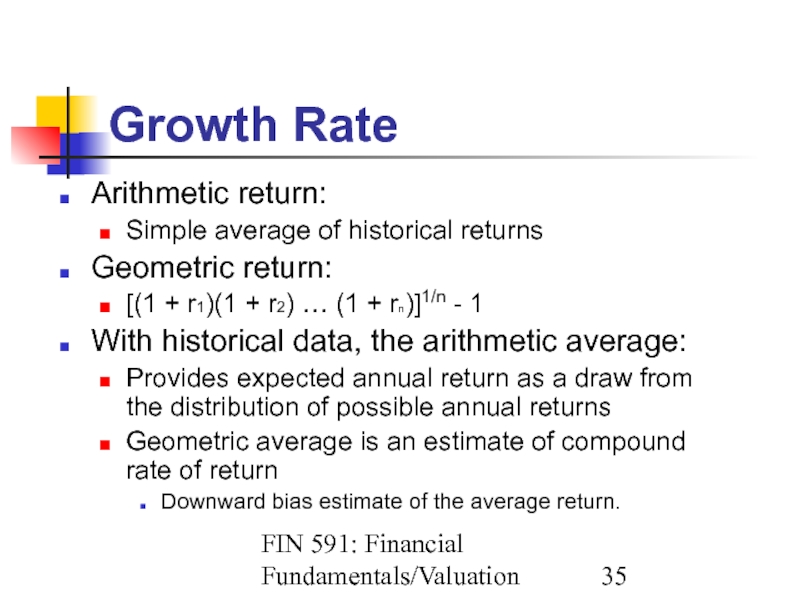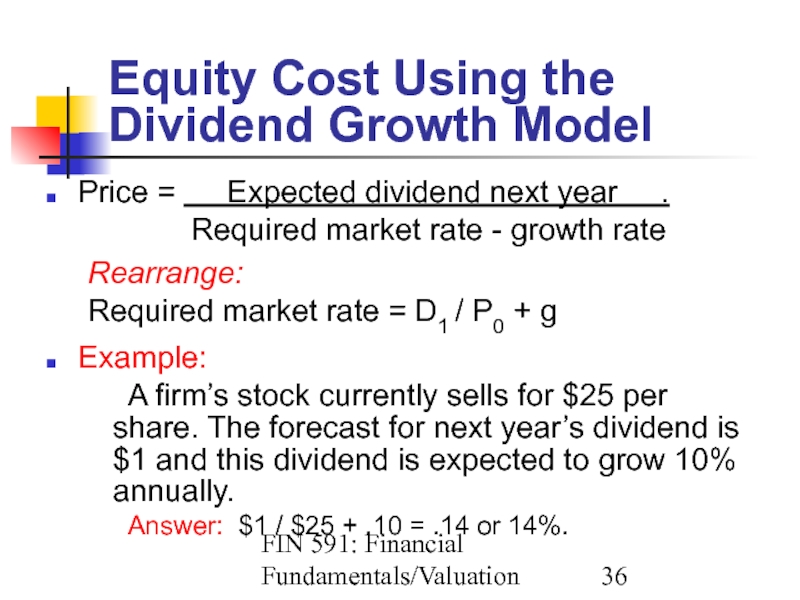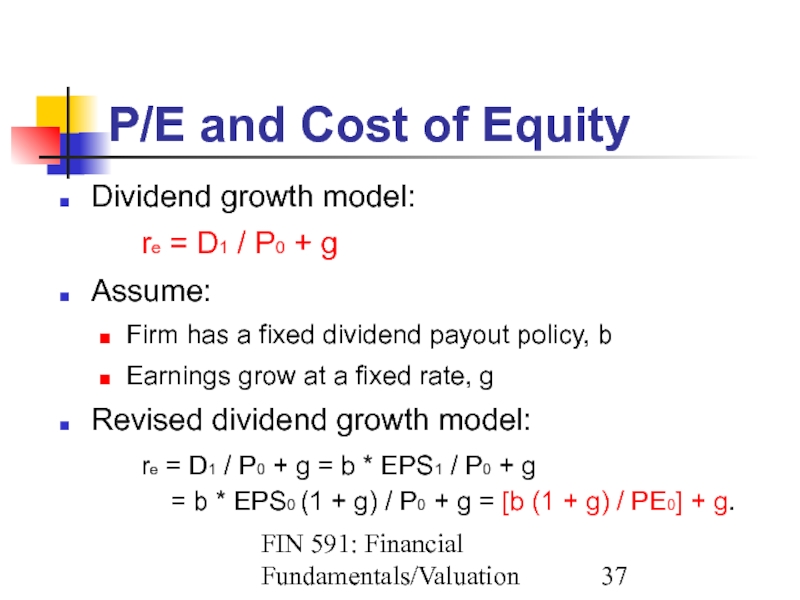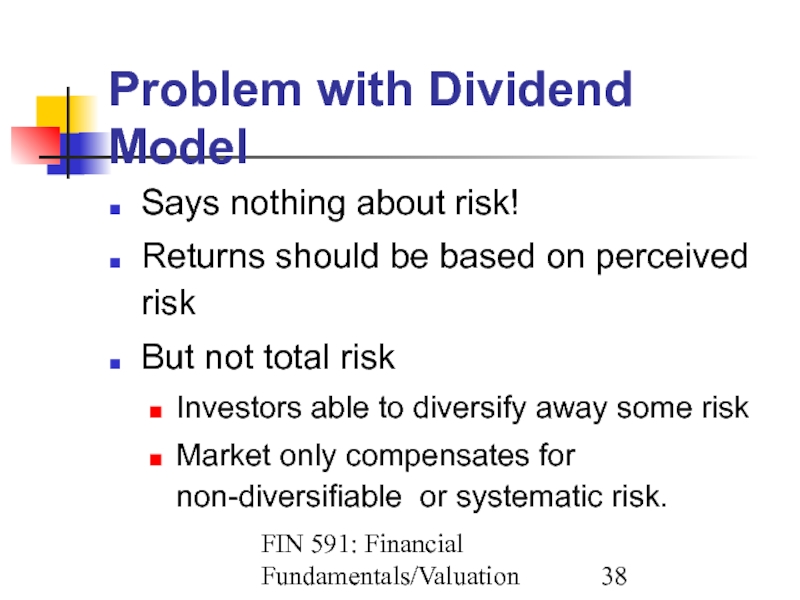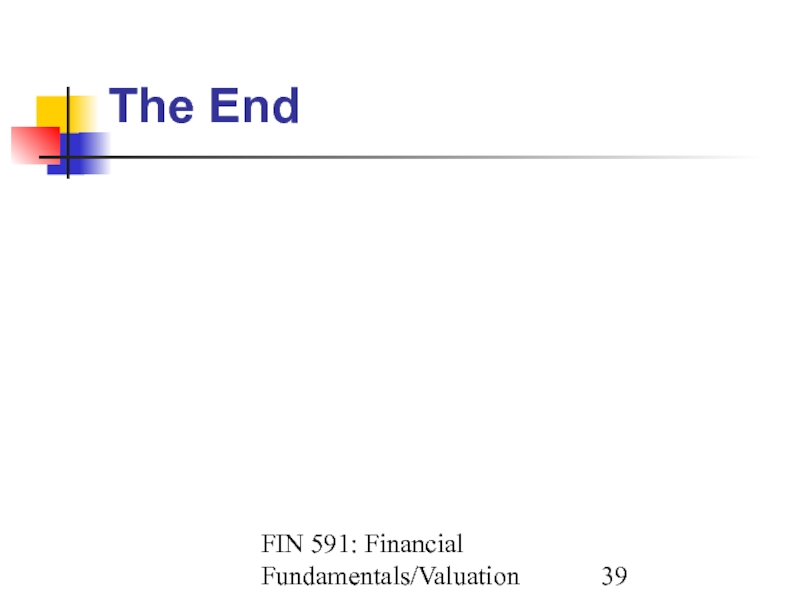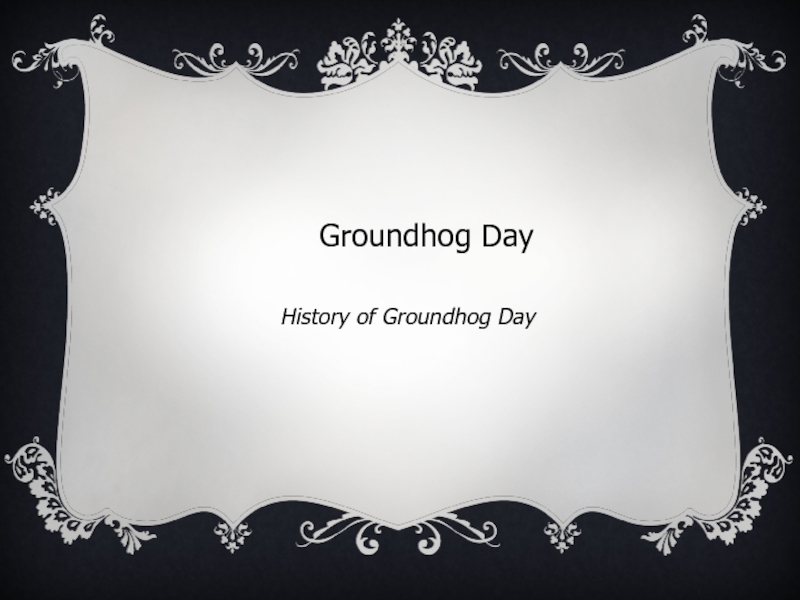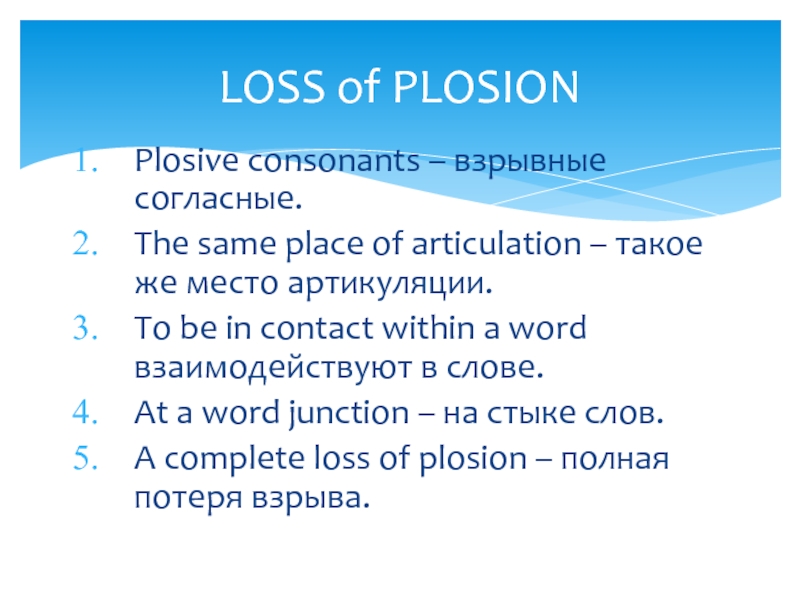- Главная
- Разное
- Дизайн
- Бизнес и предпринимательство
- Аналитика
- Образование
- Развлечения
- Красота и здоровье
- Финансы
- Государство
- Путешествия
- Спорт
- Недвижимость
- Армия
- Графика
- Культурология
- Еда и кулинария
- Лингвистика
- Английский язык
- Астрономия
- Алгебра
- Биология
- География
- Детские презентации
- Информатика
- История
- Литература
- Маркетинг
- Математика
- Медицина
- Менеджмент
- Музыка
- МХК
- Немецкий язык
- ОБЖ
- Обществознание
- Окружающий мир
- Педагогика
- Русский язык
- Технология
- Физика
- Философия
- Химия
- Шаблоны, картинки для презентаций
- Экология
- Экономика
- Юриспруденция
M&M: The Starting Point презентация
Содержание
- 1. M&M: The Starting Point
- 2. FIN 591: Financial Fundamentals/Valuation M&M: The Starting
- 3. FIN 591: Financial Fundamentals/Valuation The
- 4. FIN 591: Financial Fundamentals/Valuation
- 5. FIN 591: Financial Fundamentals/Valuation Principle of Additivity
- 6. FIN 591: Financial Fundamentals/Valuation Additivity Example
- 7. FIN 591: Financial Fundamentals/Valuation M&M
- 8. FIN 591: Financial Fundamentals/Valuation M&M
- 9. FIN 591: Financial Fundamentals/Valuation M&M
- 10. FIN 591: Financial Fundamentals/Valuation Graphing
- 11. FIN 591: Financial Fundamentals/Valuation M&M
- 12. FIN 591: Financial Fundamentals/Valuation M&M
- 13. FIN 591: Financial Fundamentals/Valuation
- 14. FIN 591: Financial Fundamentals/Valuation A Look at
- 15. FIN 591: Financial Fundamentals/Valuation Confirmation
- 16. FIN 591: Financial Fundamentals/Valuation Graphing
- 17. FIN 591: Financial Fundamentals/Valuation Another
- 18. FIN 591: Financial Fundamentals/Valuation An Aside: Introducing
- 19. FIN 591: Financial Fundamentals/Valuation Miller’s Argument VL
- 20. FIN 591: Financial Fundamentals/Valuation Net Tax Advantage
- 21. FIN 591: Financial Fundamentals/Valuation Changing the Rates
- 22. FIN 591: Financial Fundamentals/Valuation How Does NTA
- 23. FIN 591: Financial Fundamentals/Valuation A
- 24. FIN 591: Financial Fundamentals/Valuation
- 25. FIN 591: Financial Fundamentals/Valuation
- 26. FIN 591: Financial Fundamentals/Valuation
- 27. FIN 591: Financial Fundamentals/Valuation Debt’s
- 28. FIN 591: Financial Fundamentals/Valuation A
- 29. FIN 591: Financial Fundamentals/Valuation
- 30. FIN 591: Financial Fundamentals/Valuation Cost of Debt
- 31. FIN 591: Financial Fundamentals/Valuation
- 32. FIN 591: Financial Fundamentals/Valuation
- 33. FIN 591: Financial Fundamentals/Valuation Using Historic Returns
- 34. FIN 591: Financial Fundamentals/Valuation Dividend Growth Model
- 35. FIN 591: Financial Fundamentals/Valuation Growth Rate
- 36. FIN 591: Financial Fundamentals/Valuation
- 37. FIN 591: Financial Fundamentals/Valuation P/E and Cost
- 38. FIN 591: Financial Fundamentals/Valuation Problem with Dividend
- 39. FIN 591: Financial Fundamentals/Valuation The End
Слайд 2FIN 591: Financial Fundamentals/Valuation
M&M: The Starting Point
A number of restrictive assumptions
Use the additivity principle
Derive propositions re: valuation and cost of capital
Derived in both the “no tax” and “tax” cases.
Слайд 3FIN 591: Financial Fundamentals/Valuation
The M&M Assumptions
Homogeneous expectations
Homogeneous business risk (σEBIT) classes
Perpetual
Perfect capital markets:
Perfect competition; i.e., everyone is a price taker
Firms and investors borrow and lend at the same rate
Equal access to all relevant information
No transaction costs (no taxes or bankruptcy costs).
Слайд 4FIN 591: Financial Fundamentals/Valuation
Business Risk
Business risk:
Risk surrounding expected operating cash flows
Factors
High correlation between the firm and the economy
Firm has small market share in competitive market
Firm is small relative to competitors
Firm is not well diversified
Firm has high fixed operating costs.
Слайд 5FIN 591: Financial Fundamentals/Valuation
Principle of Additivity
Allows you to value the cash
Either value each individual component at its own risk adjusted discount rate (RADR)
Or value the sum of the components at the RADR that is appropriate to the sum
The concept:
PV[A + B at RADR appropriate to (A + B)]
= PV(A at RADR appropriate to A)
+ PV(B at RADR appropriate to B).
Слайд 6FIN 591: Financial Fundamentals/Valuation
Additivity Example
Market risk premium = 8%; risk-free rate
RADR of A = 6% + 1 * 8% = 14%
RADR of B = 6% + 2 * 8% = 22%
Value of A = $100 / 1.14 = $87.72
Value of B = $150 / 1.22 = $122.95
Portfolio = $87.72 + $122.95 = $210.67
Verify the answer from a portfolio perspective.
Слайд 7FIN 591: Financial Fundamentals/Valuation
M&M Capital Structure Propositions (No Taxes)
M&M Proposition
Value of unlevered firm = value of levered firm
M&M Proposition II:
re = ru + (ru - rb) B / S
rb = cost of debt
re = cost of equity
ru = cost of capital for all-equity firms in this risk class
B = value of debt
S = value of stock or equity.
Also, defined as
return on assets
Слайд 8FIN 591: Financial Fundamentals/Valuation
M&M Propositions I & II
(No Taxes)
Investment Alternative
Financing Alternatives
Unlevered Levered
Equity $5,000 $4,000
Debt (rb = 5%) $1,000
Cash Flows
EBIT $1,000 $1,000
– Interest –50 = (.05)1,000
EBT 1,000 950
– Tax (0%)
Net income 1,000 950
→ Cash flows debt + equity $1,000 $1,000
Слайд 9FIN 591: Financial Fundamentals/Valuation
M&M Propositions I & II
(No Taxes)
Proposition I:
VU = S = (EBIT) / ru = $1,000 / .1 = $10,000
VL = B + S = [Int + (EBIT - Int)] / ru = $1,000 / .1 = $10,000
⇒ S = VL – B = $10,000 – $1,000 = $9,000
⇒ Capital structure: irrelevant without corporate taxes
Proposition II: re = ru + (B/S ) (ru – rb)
ru = .10 + ($0 / $10,000) (.10 – .05) = 10%
re = .10 + ($1,000 / $9,000) (.10 – .05) = 10.556%
WACC = 10.556% * 90% + 5% * 10% = 10%.
Слайд 10FIN 591: Financial Fundamentals/Valuation
Graphing the M&M No-Tax Relationships
Firm value (Proposition I)
VU VL
Debt
Required return on equity (Proposition II) re
Slope = (ru – rb )
ru WACC
Debt/equity
Слайд 11FIN 591: Financial Fundamentals/Valuation
M&M Capital Structure Propositions (Corporate Taxes)
M&M Proposition I:
VL
M&M Proposition II:
re = ru + (B / S) (1 – τc ) (ru – rb)
where
τc = Corporate tax rate
Other variables are as previously defined.
Слайд 12FIN 591: Financial Fundamentals/Valuation
M&M Propositions I & II (Corporate Taxes)
Investment and
After-tax cost of capital for unlevered firm ru = 10%; τC = 34%
Cash Flows Unlevered Levered
EBIT $1,000 $1,000
– Interest –50 = (.05)1,000
EBT 1,000 950
– Tax (34%) – 340 – 323
Net income 660 627
→ Cash flow debt + equity $ 660 $ 677
$17 difference = $50 interest x 34% tax rate
Слайд 13FIN 591: Financial Fundamentals/Valuation
Tax Benefit of Debt Financing
Debt interest is tax
For every $1 of interest expense:
Company pays $1 * (1 - τ)
Government pays $1 * τ
Example:
Income tax savings = Interest expense * τ
= $50 * .34 = $17
PV of gov’t subsidy adds value to stock
PV tax savings = Income tax savings / market rate
= $17 / .05 = $340.
Слайд 14FIN 591: Financial Fundamentals/Valuation
A Look at the Propositions
Proposition I: VL =
VU = EBIT (1 – τC) / ru = $660 / .1 = $6,600
VL = VU + τ C B = $6,600 + $340 = $6,940
⇒ S = VL – B = $5,940.
Proposition II: re = ru + (B / S ) (1 – τc ) (ru – rb )
ru = .10 + ($0 / $6,600) (1–.34) (.10 – .05) = 10%
re = .10 + ($1,000 / $5,940) (1 – .34) (.10 – .05) = 10.556%
WACC = (B / VL ) (1 – τc ) rb + (S / VL ) re
= ($1,000 / $6,940) (1 – .34) (.05)
+ ($5,940 / $6,940) (.10556) = 9.51%.
Слайд 15FIN 591: Financial Fundamentals/Valuation
Confirmation
VL = B + S
= rb B / rb
= $50 / .05 + ($1,000 – $50) (1 – .34) / .10556
= $1,000 + $5,940 = $6,940
VL = EBIT (1 –τc) / WACC = $660 / .0951
= $6,940.
Слайд 16FIN 591: Financial Fundamentals/Valuation
Graphing the M&M Relationships
Firm
VL
Slope = τc
VU
Debt
Required return on equity (Proposition II) re
Slope = (1 – τc )(ru – rb )
ru WACC
rb
Debt/equity
Слайд 17FIN 591: Financial Fundamentals/Valuation
Another Look
with Corporate Taxes
Market Value Balance Sheet (All
Physical assets = $1,000(1 – .34)/(.1) Equity = $6,600
= $6,600 (1,000 shares at $6.60)
Market Value Balance Sheet (Upon announcement of debt issue)
Physical assets $6,600 Equity = $6,940
(1,000 shares at $6.94)
Present value of tax shield = TC B
= (.34) ($1,000) = $340
Total assets = $6,940
Market Value Balance Sheet (After exchange has taken place)
Physical assets $6,600 Equity = $5,940
(855.91 shares at $6.94)
Present value of tax shield = TC B
= (.34) ($1,000) = $340 Debt = $1,000
Total assets = $6,940 Debt plus equity
= $6,940
Слайд 18FIN 591: Financial Fundamentals/Valuation
An Aside:
Introducing Personal Taxes
Miller (1977) suggests that debt
Advantages derive from the tax deductibility of interest at the corporate level
Disadvantages because personal taxes levied on interest income usually exceed those levied on equity income
Why?
Easy to defer equity income
Non-dividend paying stocks
Push capital gains into the future
What is the effect on firm value?
Слайд 19FIN 591: Financial Fundamentals/Valuation
Miller’s Argument
VL = VU + [1 - (1
If (1 - τc) (1 - τs) / (1 - τb) > 1
It is less costly to pay the dollar to shareholders than to debt holders
Assume a constant corporate income tax rate
Need τs < τb
If (1 - τc) (1 - τs) / (1 - τb) < 1
It is more costly to pay the dollar to shareholders than to debt holders.
Слайд 20FIN 591: Financial Fundamentals/Valuation
Net Tax Advantage
PV of net tax advantage (NTA)
NTA = 1 - (1 - τc)(1 - τs) / (1 - τb)
How large is the net tax effect of debt?
Assume: τc = 34%; τs = 28%; τb = 39.5%
NTA= 1 - (1 - .34)(1 - .28) / (1 - .395) = 21.45%
If τs = τb, the NTA = _____
Conclusion:
Debt may have less impact than the M&M position.
Слайд 21FIN 591: Financial Fundamentals/Valuation
Changing the Rates
Suppose shareholders can defer taxes, thereby
NTA = 1 - (1 - τc)(1 - τs) / (1 - τb)
Then NTA = 7.3%
Suppose τc = 27.2%, τs = 15%, τb = 39.5%
Then NTA = -2.3%
Empirical evidence suggests that NTA < τc.
Слайд 22FIN 591: Financial Fundamentals/Valuation
How Does NTA
Affect M&M Model?
M&M:
VL = VU +
Miller:
VL = VU + [1 - (1 - τc)(1 - τs) / (1 - τb)] B
If τs = τb in the Miller model, then the Miller model reduces to the M&M model.
Слайд 23FIN 591: Financial Fundamentals/Valuation
A Graphical View of Miller
Value
Vu
Debt (B)
VL = VU
VL = VU + [1 - (1 - Tc)(1 - TS)/(1 - TB)]B
when (1 - TB) > (1 - Tc)(1 - TS)
VL = VU when (1 - TB) = (1 - Tc)(1 - TS)
VL < VU when (1 - TB) < (1 - Tc)(1 - TS)
Tc = corporate tax rate
TB = personal tax rate on interest
TS = personal tax rate on dividends & other equity distributions.
Слайд 24FIN 591: Financial Fundamentals/Valuation
Relationship Between
Firm Value and WACC
Value of firm
Δ(Value) / Δ(Investment)
= Marginal cost of capital to maintain firm value
ΔV / ΔI = ru (1 - τcdB / dI) = WACC
See slide #14
WACC = ru (1 - τc B / S)
= .10 (1 - .34 * 1000 / 6940) = 9.51%
Derive WACC from firm value — not vice versa
Earnings perspective
Financing perspective.
Assumes
τs = τb
Слайд 25FIN 591: Financial Fundamentals/Valuation
WACC: An Earning Power View
Assumptions:
Maintain current level of
All cash flows paid as dividends to shareholders
WACC
= Constant cash operating profits * (1 - τc)
Market value of unlevered firm
= $660 / $6,600 = 10% (see slide #9)
WACC
= Constant cash operating profits * (1 - τc)
Market value of levered firm
= $660 / $6,940 = 9.51% (see slide #14).
Слайд 26FIN 591: Financial Fundamentals/Valuation
WACC: A Financing View
Calculate the cost of:
Debt
Preferred stock
Common
Combine the different forms of capital into a weighted average cost of capital — WACC.
Слайд 27FIN 591: Financial Fundamentals/Valuation
Debt’s Yield to Maturity
Example: 14s of December 2014
$1000 $70 $70 $70 $70 $70 $70
6/97 12/97 6/98 12/98 12/07 6/08 12/08
$1,100 = $70/(1 + r) + $70/(1 + r)2 + $70/(1 + r)3 + … +$1,070/(1 + r)23
where r is a semiannual rate of interest
Find the YTM?
At r = 0%, PV = ($70)(23) + $1,000 = $2,610
At r = Infinity, PV = $0
. . .
How much is the coupon rate?
Is r greater than the coupon rate? Less than? Equal to?
Слайд 28FIN 591: Financial Fundamentals/Valuation
A Graphical View: YTM
Semiannual interest rate (r)
$2,610
$2,000
$1,100
$1,000
1
…
PV
6.17
Слайд 29FIN 591: Financial Fundamentals/Valuation
Cost of Debt
Cost of debt to the firm
Cost of debt = YTM * (1 - τc)
Example:
A firm’s debt trades in the market to provide a YTM of 5%. If the firm’s tax rate is 34%, how much is the after-tax cost of debt?
Answer: 5% * (1 - .34) = 3.30%.
Слайд 30FIN 591: Financial Fundamentals/Valuation
Cost of Debt = YTM * (1 -
Represents a good approximation if shareholders don’t default on debt service obligations
It is the rate shareholders promise the debt holders
Thus, bondholders’ expected return < YTM
See Exhibit 10.1, page 211 of text.
Слайд 31FIN 591: Financial Fundamentals/Valuation
Cost of Preferred Stock
Preferred stock dividend is not
Cost is the market return earned by investors:
Dividend / market price of preferred stock
Example:
A preferred stock (par = $20) pays a $3 dividend annually. It currently trades in the market for $24. How much is the cost of the stock from the firm’s perspective?
Answer: $3 / $24 = 12.5%.
Слайд 32FIN 591: Financial Fundamentals/Valuation
Cost of Equity
Cost of equity is more difficult
Methods commonly used:
M&M model
Dividend growth model (Gordon model)
Inverted price-earnings ratio
Security market line
Build-up approach.
Слайд 33FIN 591: Financial Fundamentals/Valuation
Using Historic Returns
Estimating cost of capital using past
Investors’ expectations for returns that compensate them for risk can’t be systematically off target
The average of past returns is the return that investors expect to receive
Sometimes the return is higher; other times lower
However, errors are not systematic.
Слайд 34FIN 591: Financial Fundamentals/Valuation
Dividend Growth Model
re = D1 / P0 +
Assumes the term structure of RADR is flat
Dividends grow at expected rate g in perpetuity
g represents sustainable growth
Use average or geometric rate?
Use real or nominal dividend growth?
1 + rreal = (1 + rnominal) / (1 + inflation)
Measure inflation by CPI.
Слайд 35FIN 591: Financial Fundamentals/Valuation
Growth Rate
Arithmetic return:
Simple average of historical returns
Geometric return:
[(1
With historical data, the arithmetic average:
Provides expected annual return as a draw from the distribution of possible annual returns
Geometric average is an estimate of compound rate of return
Downward bias estimate of the average return.
Слайд 36FIN 591: Financial Fundamentals/Valuation
Equity Cost Using the
Dividend Growth Model
Price =
Required market rate - growth rate
Rearrange:
Required market rate = D1 / P0 + g
Example:
A firm’s stock currently sells for $25 per share. The forecast for next year’s dividend is $1 and this dividend is expected to grow 10% annually.
Answer: $1 / $25 + .10 = .14 or 14%.
Слайд 37FIN 591: Financial Fundamentals/Valuation
P/E and Cost of Equity
Dividend growth model:
re =
Assume:
Firm has a fixed dividend payout policy, b
Earnings grow at a fixed rate, g
Revised dividend growth model:
re = D1 / P0 + g = b * EPS1 / P0 + g
= b * EPS0 (1 + g) / P0 + g = [b (1 + g) / PE0] + g.
Слайд 38FIN 591: Financial Fundamentals/Valuation
Problem with Dividend Model
Says nothing about risk!
Returns should
But not total risk
Investors able to diversify away some risk
Market only compensates for non-diversifiable or systematic risk.

